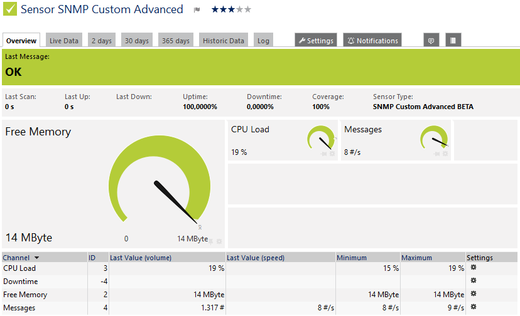Monitoring via Simple Network Management Protocol (SNMP) is one of the easiest ways to stay on top of your IT infrastructure. PRTG Network Monitor uses this common, robust and well-established protocol to gather various information you need to know about your network devices. Just have a look at the various SNMP sensors PRTG offers from the get-go.
After having determined the necessary OIDs (please see our Knowledge Base article on "How do I find out what OID I need to use for a custom sensor?"), which provide numerical values, you can use these values on an SNMP device in up to 10 different channels. Do you wonder how to get started with your customized SNMP monitoring? Just specify the channel's name, the relevant OID(s), the value types and units. Value types include the expected numeric type of the results at the given OID. You can choose between:
- Gauge (unsigned Integer): For integer values, such as 10 or 120,
- Gauge (signed integer): For integer values, such as -12 or 120,
- Gauge (float): For float values, such as -5.80 or 8.23, or
- Delta (counter): PRTG will calculate the difference between the last and the current value.
To learn more about the OID values you can choose in the sensor settings, have a look at the PRTG manual entry on the SNMP Custom Advanced sensor. This sensor type is currently in beta status, so we'd really appreciate your feedback on your experience with it.
All Sensors of the Week
You have missed other articles of our "Sensors of the Week" blog series? You have missed other articles of our "Sensors of the Week" blog series? Just take a look at the last 10 sensors:
- Packet Sniffer sensor
- Hyper-V Virtual Storage Device sensor
- SSH Disk Free sensor
- SSH Script Advanced sensor
- Cloud HTTP sensor
- SNMP Juniper NS System Health sensor
- Cloud Ping sensor
- SNMP Cisco UCS Blade sensor
- MongoDB System Health sensor
- SNMP Custom Advanced Sensor
Subscribe to our RSS feed to always stay up to date on new articles!
 Published by
Published by 













